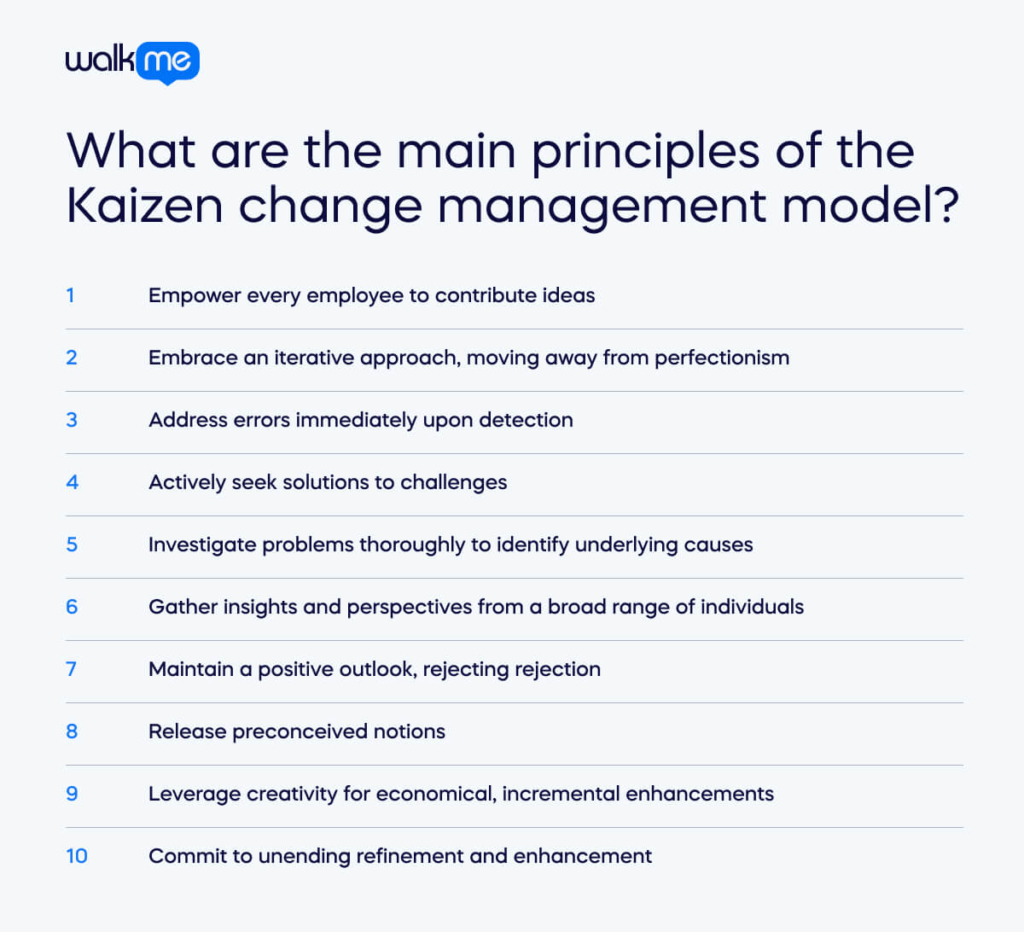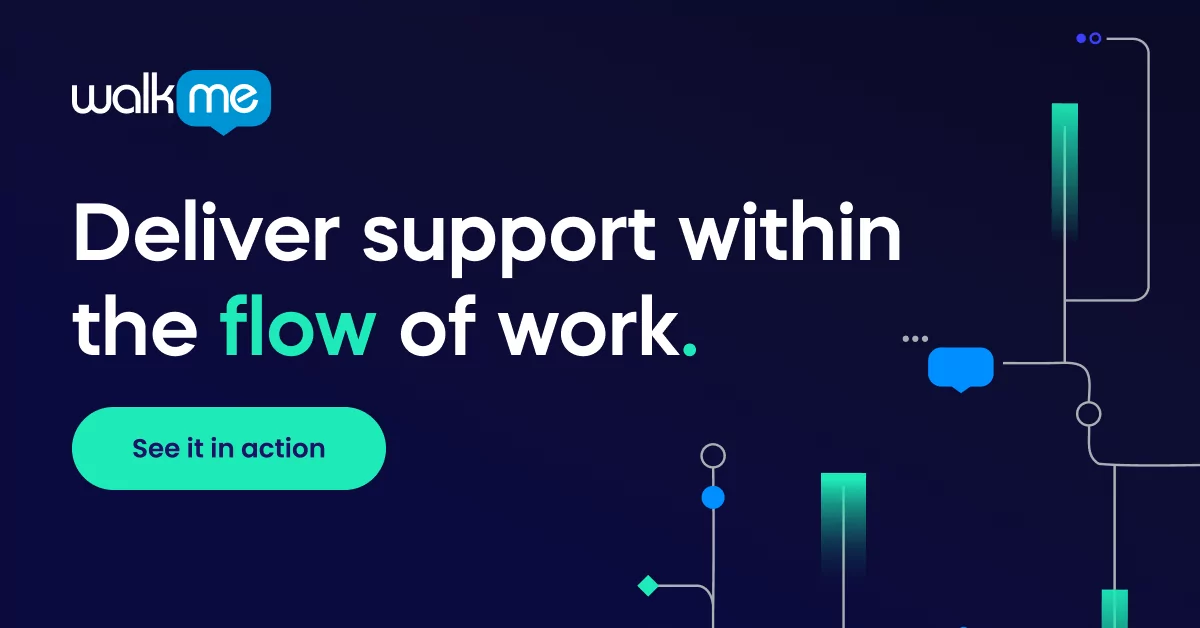When people consider change, they often go to large-scale, transformational projects that require extensive effort, substantial budgets, and significant disruption. Yet, the power of incremental change, focusing on gradual, continuous improvements, tends to be overlooked.
The Kaizen change management model champions these agile methods over dramatic overhauls.
Kaizen’s incremental change initiatives might involve trials to explore fresh concepts and process modifications and can motivate team members to propose enhancements within their workspaces.
This method offers a more sustainable and staff-friendly approach to implementing necessary changes as a company evolves and responds to its shifting context. When effectively applied, Kaizen can yield notable gains in efficiency, quality, safety, and team spirit while curbing costs and minimizing waste.
This guide will define the Kaizen change management model and its origins, outline its key principles, and explain the steps to implementing it within your organization with practical examples.
What is the Kaizen change management model?
The Kaizen change management model, embodying continuous improvement in management, emphasizes small, incremental changes for significant enhancements. Rooted in collaboration and commitment, it stands apart from a top-down organizational transformation and is adaptable across various industries.
Key tools of Kaizen include value stream mapping to optimize processes, total quality management to enhance quality, Kanban to optimize workflow, and the 5S system to organize workspaces.
Kaizen Events, another tool known as Kaizen Blitz or Burst, are focused improvement projects that bring rapid results through a short-term, cross-functional team effort.
These events can target specific issues, such as eliminating waste (Waste Kaizen) or reducing process lead times (Lead-time Kaizen), demonstrating Kaizen’s versatility in addressing different operational challenges.
The success of the Kaizen model hinges on support from all organizational levels. This promotes a culture where every employee is encouraged to contribute to ongoing improvements. This approach fosters a proactive mindset toward making regular, positive changes, avoiding the need for drastic overhauls.
Originating from Japanese terms for ‘good change’ and ‘improvement,’ Kaizen is integral to lean methodologies. It can be applied universally, from manufacturing to sales and beyond, highlighting its broad applicability and effectiveness.
Origin of the Kaizen change management model
Kaizen traces its roots back to World War II when the U.S., entering the war, tasked a team led by W. Edwards Deming, an engineer and statistician, with the challenge of converting automobile factories into tank manufacturing facilities quickly and resource-efficiently.
Deming encouraged workers to suggest minor improvements to their workflows, which led to significant, measurable enhancements in productivity and innovation.
Post-war, Deming went to Japan to aid in reconstructing its manufacturing sector. His principles resonated deeply with the Japanese, notably with businessman and industrial engineer Taiichi Ohno, who applied Deming’s quality control methods to achieve unprecedented success in manufacturing, notably through the Toyota Production System (TPS).
TPS, or ‘just-in-time’ manufacturing, emphasizes waste reduction and efficiency through continual improvement, embodying the essence of Kaizen.
Unlike earlier practices at companies like Ford or GM, where cars were sold without rigorous quality checks, the Deming-inspired approach ensured every component was inspected during assembly. Any detected issues were addressed immediately, halting production if necessary.
This shift towards empowering line workers with quality control responsibilities significantly departed from previous methods.
The concept of Kaizen gained wider recognition and adoption in the West following the publication of Masaaki Imai’s ‘Kaizen, The Key to Japan’s Competitive Success’ in 1986, highlighting its pivotal role in Japan’s industrial excellence and competitive edge in the global market.
What are the main principles of the Kaizen change management model?

The Kaizen approach to change management is structured around ten fundamental principles designed to be implemented simultaneously and persistently.
This marks a transformative shift in organizational culture towards continuous improvement with tangible outcomes:
- Empower every employee to contribute ideas.
- Embrace an iterative approach, moving away from perfectionism.
- Address errors immediately upon detection.
- Actively seek solutions to challenges.
- Investigate problems thoroughly to identify underlying causes.
- Gather insights and perspectives from a broad range of individuals.
- Maintain a positive outlook, rejecting rejection.
- Release preconceived notions.
- Leverage creativity for economical, incremental enhancements.
- Commit to unending refinement and enhancement.
Practical Kaizen change management model applications
Various examples of organizations have implemented the Kaizen change management model in real life.
Let’s look at some practical examples:
Vanderbilt University Medical Center
In the past, declarations from healthcare organizations have underscored the importance of continuous quality improvement (CQI), which is deeply influenced by the kaizen methodology, known for advocating incremental, cost-effective enhancements. Inspired by the success of Kaizen programs in companies like Toyota, it was believed that the emergency department (ED) could greatly benefit from a similar approach.
Consequently, a CQI program, rooted in kaizen principles, was developed for the Department of Emergency Medicine physician staff at Vanderbilt University Medical Center. This program was built around a suggestion-based model encouraging the submission of kaizen initiatives (KIs) through a web-based tool named the Kaizen Tracker, designed to facilitate the proposal and execution of these initiatives.
Over four years, the program’s methodology was refined, leading to a comprehensive review of the KIs’ characteristics, the extent of participation among residents and faculty, and the Kaizen Tracker’s effectiveness. The data showed that in the years following implementation—2006, 2007, and 2008—169, 105, and 101 KIs were submitted, respectively.
A significant portion of these initiatives, 76%, pinpointed a ‘process problem,’ with 53% resulting in operational changes within the ED. Remarkably, 93% of resident physicians contributed at least one KI, with 73% submitting multiple initiatives. Among attending physicians, 69% submitted at least one KI, with 89% of these contributors submitting more than one.
Over these four years, Vanderbilt’s Kaizen program has been extensively used within the ED, leading to more than 400 changes in the adult ED system and successfully leveraging CQI to facilitate improvements.
While the program’s direct impact on patient outcomes has yet to be determined, its potential as an effective tool for quality improvement in other departments is evident. This suggests that the Kaizen Program’s approach to quality improvement merits further investigation through multicenter prospective studies.
Summize
The digital contracting software company Summize adopted a unique approach to learning, moving away from the conventional one-size-fits-all methodology.
CEO Tom Dunlop, drawing from his experiences as a badminton player for Team GB, introduced the concept of kaizen, a principle of continuous improvement from Japan. During his time as a professional athlete, he focused on identifying small improvements that could enhance his performance on the court. Dunlop recalls the critical nature of marginal gains, noting that minor diet or training routine adjustments could be the deciding factor in winning championships.
This philosophy of seeking continuous improvement has been seamlessly integrated into Summize’s corporate culture. Employees at Summize are motivated to propose ways to improve by 1% each month, seeking out small enhancements that contribute to the company’s growth.
Dunlop aimed to foster a workplace culture that eschews micromanagement and gives employees the autonomy to contribute ideas and make self-driven improvements, aligning with the company’s vision and the ethos of kaizen.
To incentivize innovation and self-improvement, Summize rewards employees who propose the most impactful personal or business process improvements each month with a bonus equivalent to 1% of their salary.
Furthermore, to support their professional and personal development goals, the company allocates a £400 annual budget to each staff member. This budget can be spent on a wide range of learning activities, from training courses to fitness classes, allowing employees to choose how they wish to develop themselves beyond the confines of their job roles.
Dunlop emphasizes the importance of personal choice in development, advocating for flexibility in learning opportunities that cater to individual interests and goals rather than prescribing mandatory training on topics deemed beneficial by the company. This approach underlines Summize’s commitment to nurturing a rewarding and flexible learning environment.
Dell
Jen Felch, the Chief Digital and Information Officer at Dell Technologies, is an advocate for the company’s lean and agile methodology, which is also a common feature of Kaizen’s iterative change management model.
Felch credits this iterative approach with yielding significant results, highlighting its role in fostering a culture of openness and collaboration both within the company and with trusted partners.
She points out the effectiveness of combining skilled technologists with strong business partners and leveraging modern IT practices, such as a developer experience centered on self-service, to spearhead transformation. According to Felch, this synergy has led to numerous benefits, including enhanced customer experience, increased employee satisfaction, and cost reduction.
Dell Technologies has reallocated approximately 10% of its workforce to the development team by streamlining processes to eliminate redundant work and minimize manual tasks or testing. This shift allows for more direct engagement with business partners in creating new solutions.
Moreover, the company has achieved a 30% reduction in cycle time for deploying new capabilities and a 31% decrease in incidents requiring user assistance. Felch attributes these improvements to a dedication to user experience, addressing the root causes of problems, and emphasizing quality in new capabilities.
Felch summarizes the outcomes of these efforts by stating that Dell Technologies has become faster and more responsive, with quality enhancements and stronger engagement with business partners, epitomizing the essence of digital business transformation.
What does the Kaizen mean for change management?
The Kaizen change management model emphasizes making continuous improvement a core part of an organization’s culture. This approach values the relentless pursuit of innovation, efficiency, and excellence, with every employee encouraged to contribute to problem-solving and process enhancement.
It advocates for questioning the status quo, fostering continuous training, and viewing mistakes as opportunities for growth. In essence, change management is not a one-off goal; it is something that we should pursue continuously.
A major advantage of adopting Kaizen is its ability to cultivate an environment centered on continuous enhancement. Kaizen encourages team members to pinpoint opportunities for improvement and grants them the autonomy to implement these changes.
This approach promotes a culture of ownership and empowerment, significantly boosting engagement, innovative thinking, employee contentment, and creativity across the organization. Over time, this model can result in less resistance to change as employees are encouraged to co-create change.
Key Kaizen strategies include streamlining workflows by eliminating waste, adopting a demand-driven production system, and encouraging staff to engage directly with operational areas (the Gemba) to identify and solve problems at their source.
It also emphasizes empowering teams with the training and resources needed for improvement and promotes long-term planning for sustainable change outcomes.
In summary, Kaizen is about embedding a culture of continuous improvement across all organizational levels to achieve long-term change and adaptability.
Step-by-step guide to implementing the Kaizen change management model applications

In a corporate environment, the Kaizen change management model emphasizes making ongoing, incremental adjustments to enhance performance across all organizational tiers.
It entails pinpointing challenges and opportunities, devising and implementing solutions, and revisiting the cycle to refine any issues or dilemmas that weren’t fully resolved initially.
The Kaizen methodology encompasses various stages, but the essential steps to adhere to include:
Making sure your goals and vision are aligned with Kaizen
The successful integration of Kaizen within an organization begins with a clear, compelling vision of what the organization aims to achieve through continuous improvement efforts. This vision must align closely with the organization’s strategic business priorities to ensure that Kaizen initiatives drive the company toward its long-term goals.
By setting SMART goals, organizations can provide a clear direction for Kaizen efforts, facilitating measuring and tracking progress. This strategic alignment creates a unified sense of purpose and direction, enhancing stakeholder engagement and providing a solid rationale for embracing change.
Using various types of data to identify inefficiencies
Identifying improvement areas necessitates a comprehensive approach to data gathering and process analysis. This involves collecting data on current operations, analyzing these processes for inefficiencies or bottlenecks, and setting precise goals for enhancement.
For instance, a financial institution noticing extended wait times for mortgage offers would undertake an in-depth analysis of the timeline from application to offer, seeking areas for efficiency gains.
Flowcharts, process maps, and Gemba Walks—a technique where leaders observe processes in their real context—directly uncover inefficiencies. Engaging with employees and customers for feedback provides additional insights, ensuring that improvement plans are grounded in actual needs and experiences.
Starting implementation with a small-scale Kaizen event
Kaizen events are intensive workshops that convene diverse teams to focus on specific improvement opportunities. These events are characterized by their collaborative nature, involving employees at all levels in the creativity and problem-solving process. The objective is to emerge with a concrete, actionable plan that can be quickly implemented.
Starting with a pilot allows for testing solutions on a small scale, ensuring any adjustments can be made before broader application. This phase is crucial for validating the effectiveness of proposed changes and preparing the organization for a wider rollout.
Establishing an effective training program before the wider rollout
A critical component of embedding Kaizen in an organization is developing and delivering employee training programs focused on critical areas such as process efficiency, safety, and waste elimination.
Training might involve practical adjustments to work processes, such as reconfiguring assembly lines to improve flow or retrofitting equipment to enhance safety. Effective Kaizen training is tailored to meet the organization’s unique needs while fostering a universal commitment to identifying and addressing inefficiencies.
Evaluating the impact of the pilot event
After implementing improvements, assessing their impact using predefined sales performance metrics and feedback is vital. This evaluation helps determine the initiative’s success and whether further adjustments are needed. Celebrating achievements and recognizing employee contributions at this stage are essential for maintaining morale and motivation.
Communicating the results and learnings from Kaizen initiatives reinforces the value of continuous improvement efforts and builds a foundation for future projects.
Formalizing the new improvements as the rollout begins
The final phase involves standardizing the successful changes, documenting new processes, and integrating these improvements into the organization’s operations. This may include updating employee performance metrics, training staff on new procedures, and adjusting the organizational culture to reflect the new practices.
Ensuring that these changes become a permanent and valued part of the organization’s workflow is crucial for sustaining the benefits of Kaizen over the long term.
Understanding that Kaizen should be a sustained, ongoing process
Kaizen is a dynamic process that requires continuous attention and effort. Organizations must remain committed to seeking out new areas for improvement, staying adaptable to market or operational environment changes, and fostering a culture of learning and adaptation.
This continuous improvement cycle ensures that Kaizen’s efforts remain relevant and practical, driving the organization toward greater business efficiency, competitiveness, and success.
The future of the Kaizen change management model
Kaizen represents a journey of ongoing enhancement rather than a fixed destination. The Kaizen Change Model offers a valuable framework for organizations that foster perpetual progress and actively involve their workforce in transformation efforts.
This approach emphasizes setting achievable objectives, making incremental improvements, and nurturing a learning culture steeped in continuous development, paving the way for enduring organizational advancement. While adopting Kaizen demands dedication and time, the payoff in enhanced operational efficiency, heightened effectiveness, and bolstered market competitiveness can be significant.
Initiating Kaizen begins with a thorough examination of existing processes. Critical first steps include Undertaking Gemba Walks to observe operations firsthand, analyzing performance data, and engaging with employees to unearth inefficiencies or problems.
Once you’ve identified potential areas for improvement, selecting an appropriate Kaizen event tailored to address these specific challenges can kickstart your journey toward continuous improvement.


